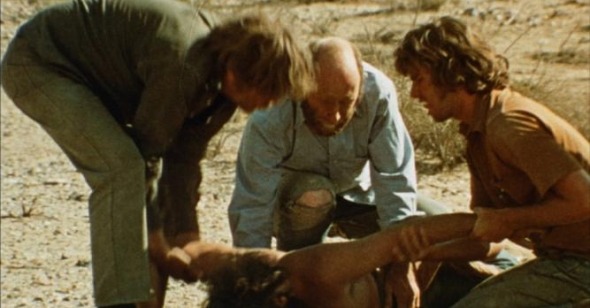American Graffiti
Saul Austerlitz on Punishment Park
Here’s the deal: young radicals arrested and convicted of a serious offense by the U.S. government have two choices. They can serve their full term, anywhere from five years to life, or they can survive a set period of time in Punishment Park, an open hunting preserve in the American West, where the game being hunted is hippie scum. The convicts are loosed in bunches into the park without food, water, or weapons, with the goal to reach an American flag located on a hilltop some 25 miles away. Given a few hours’ lead time, they are soon followed in hot pursuit by military and law enforcement personnel, whose job it is to track down the convicts and kill them. Figuring that regardless of how terrible Punishment Park may be, it will be over with some rapidity, and most of the convicts choose it as the means of serving out their sentences.
Here’s the other deal: the rules, as stated by the government and its representatives, are a farce. The game of Punishment Park is an excuse for the U.S. government to hunt down and murder those individuals it deems unacceptable for polite American society. The endpoint, conveniently marked by the Stars and Stripes, is near-impossible to reach, and provides no respite from the carnage regardless.
Where the hell are we? We’re in the highly radicalized, politicized, and deeply angry world of British filmmaker Peter Watkins, probably the greatest filmmaker that you’ve never heard of. Watkins’s Punishment Park (1971) is his deepest incursion into the American psyche, and the centrality of violence in American political and social life. At the center of Watkins’s films is his foregrounding of style, and key to Watkins’s style is the borrowing of documentary tropes for his quasi-documentary fictions. Beginning with his stunning first two features, The Battle of Culloden (1964) and The War Game (1965), and continuing through his most recent work, the incomparable six-hour epic La Commune: Paris 1871 (2000), Watkins persistently draws attention to the films’ “reality,” which leads savvy viewers to see their patent lack of documentary truth, which in turn brings a realization of the films’ dedication to a truth deeper than documentary, reached through the false screen of doc mise-en-scène. Witness The War Game, where the combination of impassive narration and a verite-style camera reveal the unbearable reality of nuclear catastrophe better than a hundred On the Beaches could ever manage. Watkins is dedicated to two principles above all: returning the blood to the lifeless corpse of history and an uncontrollable need to speak truth to power.
Watkins’s career has flitted between histories of what once was and histories of what never has been. In the former category are Culloden, which reenacts a famously bloody skirmish between English and Scottish forces in 1746, and La Commune, which revisits the events of the Paris Commune of 1871. In the latter category are such tweaked versions of contemporary reality as the rocker-as-god satire Privilege, the unshakably disturbing War Game, and Punishment Park. What unites the two strands of Watkins’s oeuvre is the faux-documentary casing surrounding them. Watkins is one of the first mockumentarians, but banish any thoughts of Christopher Guest from your head; Watkins is dead serious, his films attempt to dethread the fabric of history.
Punishment Park stems directly from the culture wars of the sixties and is reflective of the post-1968 silent majority backlash against liberal mores. It is America versus its own, the desire of the straights to weed out those undesirables whose discontent with American life they find unacceptable. Punishment Park cuts between scenes in the park and of a number of easily recognizable types having their day in court. It’s a Murderer’s Row of Sixties oppositional types: the angry Black Panther-esque nationalist, the hippie female folksinger, the Jewish radical student leader, and so forth. Each of the accused takes the opportunity of appearing in front of a representative of law and order to rail against the government’s suppression of freedoms. What is striking is the deeply familiar sense of a house divided running off the rails, and an authoritarian government utilizing calls for law and order, and a faraway war, to stifle dissent at home. Vietnam may have become Iraq, and Nixon may be replaced by W., but the song remains the same. The faux-documentary strategy allows us to hear from both the radical know-it-alls who have a cure for all that ills America, and their pursuers, the police officers sent to chase them through Punishment Park. Punishment Park is like the 1968 Chicago convention turned into a theme park—“Watch the Hippies Run!”
Watkins is prescient in his understanding of the centrality of spectacle to American life; one is only surprised that he didn’t make the park the subject of a long-running, highly popular television game show, like the war games of The Gladiators. One shudders to think what Mark Burnett might do with this material today: red-state cops and military personnel chasing down Massachusetts college professors with “Re-Defeat Bush” pins on their lapels. Watkins understands that the spectacle of American politics waxes more serious while simultaneously growing into a farcical husk of its original self. Liberals and conservatives polarize into warring groups, while the entire big top of political debate has become nothing but a carnival of attitudes and personas. Running deeper than any political beliefs, too, is the deeply American conviction that bloodshed can be cleansing. As old as the Bible, and as American as the Book of Mormon and Taxi Driver, both the liberals and conservatives in Punishment Park believe that a little violence, appropriately directed, will go a long way toward solving the country’s problems. Punishment Park is the place where illusions of the healing power of death and destruction perish.
